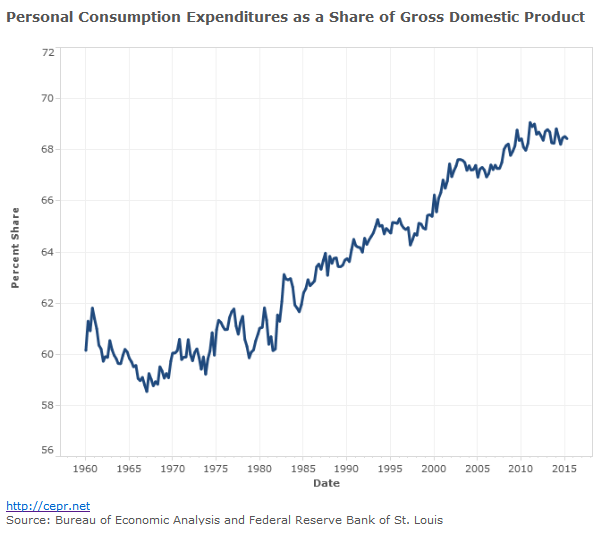Fact-based, data-driven research and analysis to advance democratic debate on vital issues shaping people’s lives.
Center for Economic and Policy Research
1611 Connecticut Ave. NW
Suite 400
Washington, DC 20009
Tel: 202-293-5380
Fax: 202-588-1356
https://cepr.net
July 30, 2015 (GDP Byte)
By Dean Baker
Downward GDP revisions show economy falling further behind potential output from 2011–2014.
The Commerce Department reported the economy grew at a 2.3 percent annual rate in the second quarter, a substantial improvement from the 0.6 percent rate in the first quarter. The latter number was an upward revision from a previously reported decline of -0.2 percent. The biggest factors were a turnaround in the trade balance and an uptick in the rate of consumption growth.
In the first quarter, exports fell at a 6.3 percent annual rate. This was partly the result of the rise in the value of the dollar in 2014, but also partly the result of slowdowns at West Coast ports due to a labor dispute. With the labor dispute now settled, exports rose at a 5.3 percent rate in the second quarter, still leaving them below their level from the fourth quarter of 2014. The improvement in the trade balance contributed 0.13 percentage points to growth after subtracting 1.92 percentage points in the first quarter.
Consumption grew at a 2.9 percent annual rate in the second quarter, up from a weather-depressed 1.1 percent rate in the first quarter. The biggest change was in durable goods. People who put off buying cars in the harsh winter weather instead bought in the second quarter, leading to a 7.3 percent rate of increase in durable good sales compared to a 2.0 percent rate in the first quarter. Consumption contributed 1.99 percentage points to growth in the second quarter compared to 1.19 percentage points in the first quarter.
The personal saving rate was 4.8 percent for the quarter, the same as the average of 2014. This should end speculation about why people are not spending their dividend from lower gas prices, since the data indicate they are. Consumption is at near-record highs as a share of GDP, which makes the frequent fretting over cautious consumers seem more than a bit peculiar.
Investment was very weak in the quarter, shrinking at a 0.6 percent annual rate. Equipment spending fell at a 4.1 percent rate, and spending on structures fell at a 1.6 percent rate after dropping at a 7.4 percent rate in Q1. It is likely that overbuilding in some areas will lead to further weakening of structure investment in future quarters. Residential construction grew at a 6.6 percent rate, down from a 10.1 percent rate in the first quarter. Government spending rose at a 0.8 percent rate as a 2.0 percent rise in state and local spending more than offset a drop of 1.1 percent at the federal level.
The revisions show the recovery to have been weaker than previously reported. Growth for the years 2012–14 averaged just 2.0 percent, down from a previously reported 2.3 percent. This means the economy was growing less rapidly than most estimates of potential GDP growth, implying the economy was falling further below its potential level of output during this period instead of making up the ground lost during the recession.
The revised data also show a somewhat smaller profit share in the last two years. Before-tax profits were revised down by $69.5 billion (3.3 percent) in 2013 and $16.9 billion (0.8 percent) in 2014. With these revisions, the profit share of corporate income peaked in 2012 and has been drifting downward for the last two years.
The data on health care spending continue to look very good. Spending on health care services, which accounts for the vast majority of health care spending, rose at a 2.7 percent annual rate in the quarter, virtually the same as the rate over the last three years. Spending on drugs has been rising considerably more rapidly. Inflation continues to be very much under control. Over the last year, the core personal consumption expenditure (PCE) has risen by 1.3 percent, well below the Fed’s 2.0 percent target.
On the whole, this report suggests that the economy is likely to continue to grow at a very modest pace. Consumption growth will likely be slower in the second half of the year, with investment likely to be somewhat stronger. The net is likely to lead to a growth rate of close to 2.0 percent. If it had not been for extraordinarily weak productivity growth, this would imply a very slow rate of job creation.
